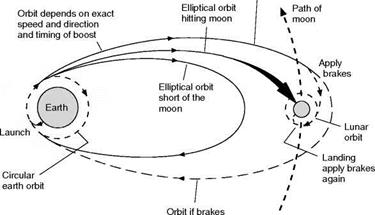Another way to the moon
But man has been to the moon – more than once – and has come back again; perhaps even more remarkable the Russians have sent spacecraft to the moon – without a man – have brought at least one back with samples, and have driven a moon-bug about on the surface! How has it been done? For the answer we must go back to circular and elliptical orbits. For a horizontal speed of launch of 10.46 km/s (just below the escape velocity), from a height of about 800 km, gives an elliptical orbit which will strike the moon, and at velocities of launch slightly above this, orbits will pass round both the earth and the moon (Fig. 13.12).
But the moon isn’t such an easy target as all that! The shape and size of the elliptical orbit is very sensitive to the exact direction and velocity of launch, and moreover the moon is itself travelling at rather over 3700 km/h, whereas the speed of the satellite at its apogee will only be about 700 km/h. Also, if the launch from the earth is made in an easterly direction – to take advantage of the earth’s rotation and consequent circumferential speed of 1600 km/h – the satellite at 700 km/h will be chasing the moon at 3700 km/h in the same direction; so it will be a case of the moon hitting the satellite rather than the satellite hitting the moon – not that it matters which hits which, but it does mean that the satellite should be launched in the other direction and so approach the moon from the front, as it were, instead of chasing it.
In practice the initial launch must be made from ground level (Fig. 13B, overleaf), and not from an altitude of 800 km, and it has been calculated that if the satellite is guided only during the launching phase, and if the angle of launch is exactly correct, there must not be an error of more than 23 m/s in the launching speed of 11125 m/s; or if the velocity is exactly correct the angle of launch must be accurate to within 0.01°. If the satellite is to pass round the moon and the earth the accuracy must be even greater, so much so that some guidance after launch is a virtual necessity.
In view of the accuracy needed, not to mention the expense and man-power involved, it would be a mistake to imagine that flights to the moon or other planets have become, or are ever likely to become commonplace. None the less the experience so far gained has resulted in what might be called a standard procedure consisting of –
1. The launch to orbital height and speed.
2. One or more orbits of the earth.
|
Elliptical orbit going beyond moon
not applied when near moon |
Fig 13.12 Sending spacecraft to the moon Not to scale.
3. Rocket boost to required speed and direction for the moon.
4. Reverse burst of power to slow down, and put into orbit round the moon.
5. Separation of lunar module, and more reverse power to give a soft landing on the moon.
6. Lift-off from the moon, and into orbit to join up again with the command module.
7. Rocket boost to required speed and direction for the earth.
8. Reverse burst to slow down and put into orbit round the earth.
9. Re-entry, splash down and pick-up.
These phases have been described in detail in the Press, on radio and television, and in numerous articles and books; our purpose here is simply to indicate how the principles of mechanics apply to these various phases.
First then, the launch.















